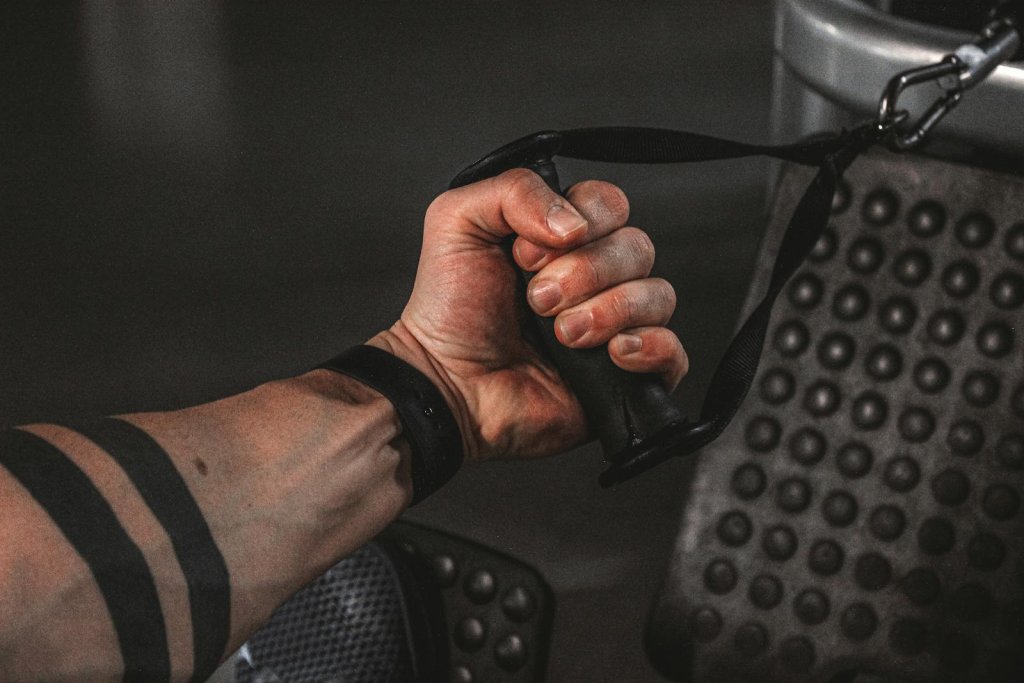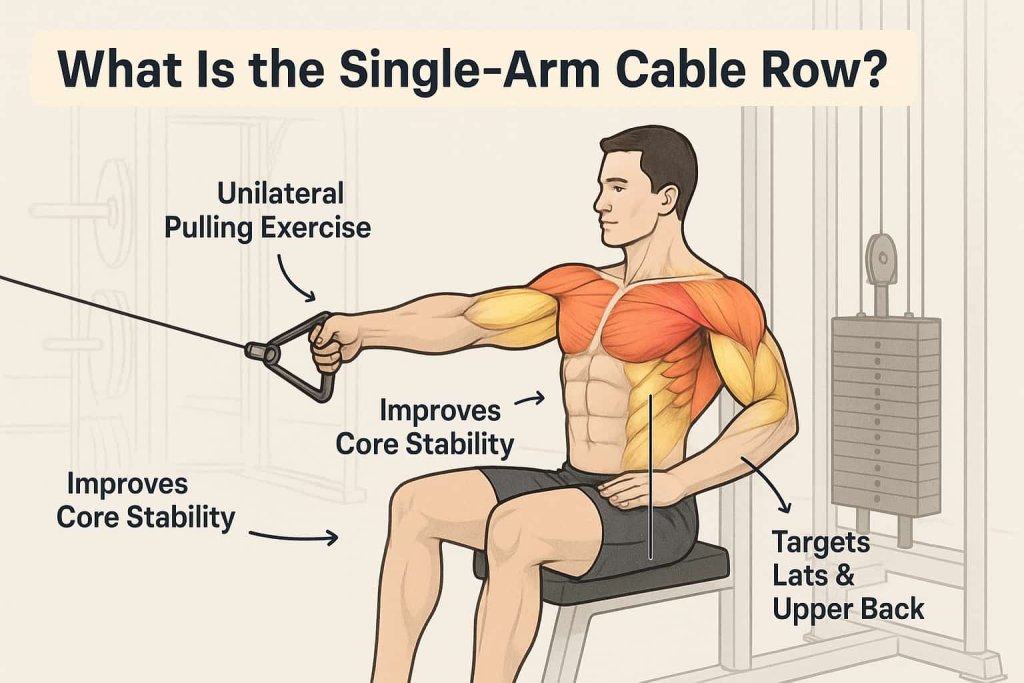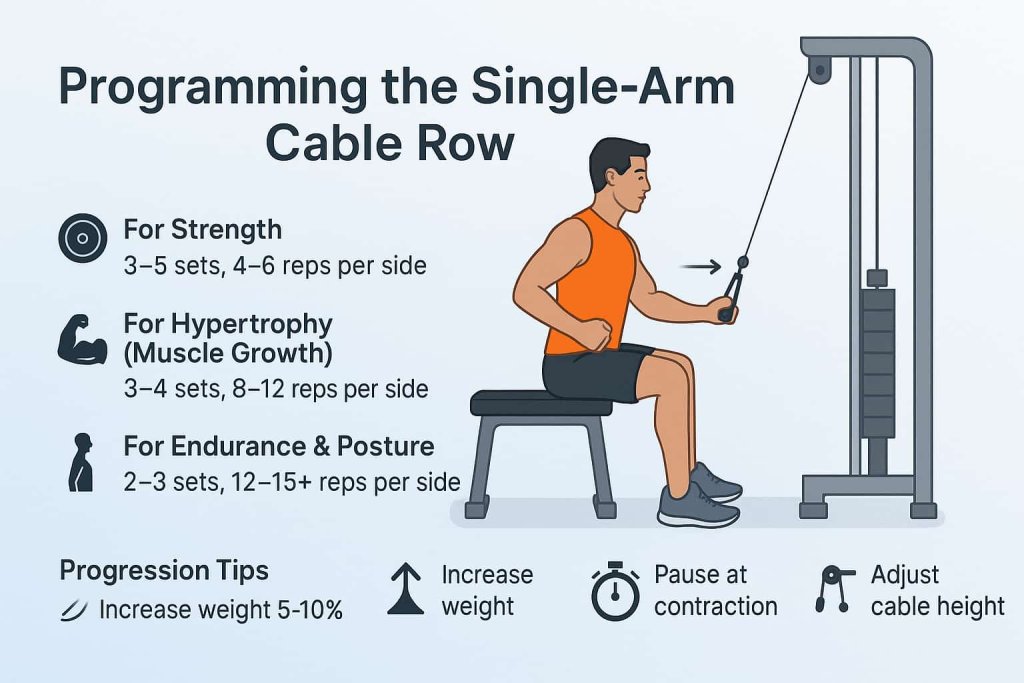The single-arm cable row is one of the best exercises for building a stronger, more balanced back. It isolates each side of your body, correcting imbalances while strengthening your lats, traps, rhomboids, and rear delts.

Learning how to master this move is important because it not only enhances muscle growth but also improves posture, core stability, and overall pulling strength. Whether you’re an athlete, bodybuilder, or casual gym-goer, the single-arm cable row can take your back training to the next level.
This guide covers proper form, benefits, mistakes to avoid, programming, alternatives, and expert tips so you can get the most from every rep.
What Is the Single-Arm Cable Row?
The single-arm cable row is a unilateral pulling exercise performed on a cable machine. Instead of using both arms at once, you pull with one arm, which increases range of motion and core activation.

Muscles Worked:
- Primary: Latissimus dorsi (lats), rhomboids, trapezius, rear deltoids
- Secondary: Biceps, forearms, erector spinae, obliques (for anti-rotation stability)
This makes it both a back-builder and a core stabilizer in one movement.
How to Do the Single-Arm Cable Row (Step by Step)
Setup
- Sit at a cable row station with a D-handle attachment.
- Place feet firmly on the platform, knees slightly bent.
- Grip the handle with one hand; keep chest tall and shoulders back.
- Use the non-working hand for stability by bracing on your thigh or bench.
Execution
- Start with your arm extended, shoulder blade protracted.
- Initiate with the back—retract and depress your shoulder blade first.
- Pull the handle toward your lower ribs or belly button, keeping elbow close to your torso.
- Squeeze your back muscles at the end range for 1–2 seconds.
- Slowly return to starting position, allowing your shoulder to protract.
Trainer Tip: Keep a slight forward lean (10–15°) for a greater stretch and longer range of motion.
Common Mistakes to Avoid
- Shrugging shoulders → Focus on pulling with your back, not your traps.
- Using momentum → Swinging or jerking reduces muscle activation. Lower the weight.
- Rotating torso → Keep core tight to prevent twisting.
- Short range of motion → Fully extend at the start and pull to your ribs for maximum benefit.
- Letting chest collapse → Keep chest proud and spine neutral.
Programming the Single-Arm Cable Row (Sets, Reps & Progression)
To get the best results, program the single-arm cable row based on your training goal:

- For Strength → 3–5 sets of 4–6 reps per side with heavier weight.
- For Hypertrophy (Muscle Growth) → 3–4 sets of 8–12 reps per side at moderate weight.
- For Endurance & Posture → 2–3 sets of 12–15+ reps per side with lighter weight and slower tempo.
Progression Tips:
- Gradually increase cable resistance by 5–10% when you can complete all reps with perfect form.
- Add pauses at peak contraction to intensify the movement.
- Experiment with different cable heights to target slightly different muscle fibers.
👉 By adjusting reps, sets, and resistance, you can keep progressing while avoiding plateaus.
Single-Arm Cable Row Variations
1. Standing Single-Arm Cable Row
Why it works: Engages the core for stability while targeting the lats and upper back. Ideal for functional strength and athletic training.
Muscles Worked: Lats, rhomboids, traps, erector spinae, abs.
How to do it:
- Attach a handle to the low pulley.
- Stand with feet shoulder-width apart, knees bent slightly.
- Grip the handle with one hand and row toward your torso.
- Keep torso stable and return slowly.
Trainer Tip: Avoid twisting — think of pulling with your elbow, not your hand.
2. Incline Bench Cable Row
Why it works: Keeps your body supported, eliminating momentum and forcing strict form.
Muscles Worked: Lats, mid-traps, rhomboids, posterior delts.
How to do it:
- Set up an incline bench facing the machine.
- Lie chest-down, holding the handle in one hand.
- Row to your ribs, squeeze shoulder blades, and lower under control.
Trainer Tip: Keep your chest pressed firmly against the bench for maximum isolation.
3. High Cable Row (Single Arm)
Why it works: Shifts focus to the upper back and rear delts, balancing pressing movements.
Muscles Worked: Rear delts, rhomboids, traps, teres major.
How to do it:
- Set pulley above shoulder height.
- Grip the handle, step back slightly.
- Pull diagonally down toward your chest.
- Control the release back to start.
Trainer Tip: Lead with your elbow slightly outward for better rear delt activation.
4. Half-Kneeling Row
Why it works: Improves posture, core stability, and balance while working the back.
Muscles Worked: Lats, traps, obliques, hip stabilizers.
How to do it:
- Take a half-kneeling stance (one knee down, one forward).
- Hold the handle in the opposite hand.
- Row toward your waist, chest tall.
- Return slowly.
Trainer Tip: Squeeze your glutes for extra stability in the half-kneeling stance.
5. Reverse-Grip Row
Why it works: Targets the lats and biceps more directly with an underhand grip.
Muscles Worked: Lats (lower portion), biceps, forearms.
How to do it:
- Grab the handle with an underhand grip.
- Row toward your lower ribs, elbows tucked.
- Extend arm back slowly.
Trainer Tip: Keep wrists neutral — don’t curl your wrists at the finish.
Benefits of the Single-Arm Cable Row

1. Corrects Muscle Imbalances
By training each side independently, you prevent dominant muscles from compensating. This helps improve symmetry and strength balance between left and right sides.
2. Improves Mind–Muscle Connection (MMC)
Reddit fitness users note that single-arm rows deliver a better pump, contraction, and stretch than bilateral cable rows, making it easier to “feel” the lats working.
3. Enhances Core Stability
Since you resist torso rotation while pulling, your obliques and deep core stabilizers get stronger, improving posture and functional strength.
4. Builds a Stronger Back
The cable provides constant tension throughout the movement, which stimulates muscle growth more effectively than free weights in some cases.
Alternatives to the Single-Arm Cable Row
When you don’t have a cable machine, these exercises replicate the same pulling motion and provide excellent unilateral training.
A. Single-Arm Dumbbell Row
Why it works: Classic free-weight substitute that builds size and strength.
Muscles Worked: Lats, traps, rhomboids, biceps.
How to do it:
- Place one hand and knee on a bench.
- Hold a dumbbell in the other hand.
- Row to your hip, squeeze, and lower slowly.
Trainer Tip: Keep back flat — avoid rounding your spine.
B. Meadows Row (Landmine Row)
Why it works: Unique landmine variation that targets lats from a new angle and allows heavy loading.
Muscles Worked: Lats, traps, obliques, rear delts.
How to do it:
- Load one end of a barbell into a landmine.
- Stand sideways, hinge at hips, grab sleeve with one hand.
- Row toward your side, control the return.
Trainer Tip: Use lifting straps — the bar sleeve is thick and grip often fails first.
C. Resistance Band Rows
Why it works: Portable, joint-friendly, and scalable — perfect for home training.
Muscles Worked: Lats, rhomboids, rear delts.
How to do it:
- Anchor a resistance band to a sturdy point.
- Grip with one hand.
- Row toward your torso and return with control.
Trainer Tip: Step back to increase resistance and keep tension steady throughout.
D. Inverted Rows
Why it works: Bodyweight option that strengthens the back and improves scapular stability.
Muscles Worked: Lats, traps, rhomboids, core.
How to do it:
- Set a barbell in a rack or use TRX straps.
- Lie underneath and grab with one hand (or both for beginners).
- Pull chest to bar, squeeze shoulder blades, lower slowly.
Trainer Tip: Bend knees for easier reps, straighten legs for more challenge.
Single-Arm Cable Row vs Dumbbell Row
Both the single-arm cable row and the dumbbell row are excellent back-builders, but each has unique advantages.
Single-Arm Cable Row
- Provides constant tension throughout the entire movement thanks to the cable.
- Easier to adjust range of motion and angles.
- Increases core activation by resisting torso rotation.
- Great for isolating the lats and improving mind–muscle connection.
Single-Arm Dumbbell Row
- Builds raw pulling strength with free weights.
- Allows heavier loading compared to cables.
- Requires stabilization from the lower back, making it slightly more taxing.
- More accessible since most gyms and even home setups include dumbbells.
👉 Which is better? Use dumbbell rows for heavier strength work and single-arm cable rows for constant tension and hypertrophy. Many lifters benefit from including both in their back routine.Expert Tips for Mastery
- Start with your weaker side first to fix imbalances.
- Use moderate weights to prioritize muscle engagement over load.
- Add the row early in your workout for strength focus or later for hypertrophy “finisher” sets.
- For growth: aim 3–4 sets of 10–12 reps per side.
FAQ
1. Is the single-arm cable row better than the two-arm version?
Yes, because it increases range of motion, core activation, and helps correct muscular imbalances.
2. How heavy should I go?
Use a weight that allows controlled movement for 8–12 reps without twisting your torso.
3. Can beginners do this exercise?
Absolutely. Beginners should use lighter weights and focus on technique before adding load.
4. How many times per week should I do it?
2–3 times per week is effective, as part of a balanced pull or back routine.
5. Does it work the core too?
Yes, the unilateral pull creates an anti-rotation challenge, strengthening your obliques.
6. What grip should I use?
A neutral grip (palm facing inward) is most comfortable and joint-friendly.
7. Can I replace dumbbell rows with this?
Yes, in fact, cable rows offer constant tension, making them a great replacement or complement.
Conclusion
The single-arm cable row is one of the most effective exercises for building a balanced, stronger, and more aesthetic back. It improves posture, core stability, and overall pulling strength while targeting all major upper-back muscles.
If you want to maximize results, focus on perfect form, avoid common mistakes, and integrate it with other compound lifts like pull-ups and deadlifts.
👉 Next time you train back, swap in the single-arm cable row and feel the difference in your strength and symmetry.
